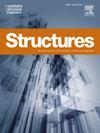A numerically stable transfer matrix method for dynamic analysis of steel-concrete composite beams
IF 3.9
2区 工程技术
Q1 ENGINEERING, CIVIL
引用次数: 0
Abstract
The conventional transfer matrix method (TMM) is prone to numerical instability when applied to long-span steel-concrete composite beams, particularly under scenarios involving intricate interfacial shear slip and shear deformation coupling effects. To resolve this limitation, this study proposes a numerically stable analytical framework for precise dynamic analysis of composite beams. The developed TMM integrates Timoshenko beam theory with a dual-layer shear deformation mechanism, explicitly modeling both interfacial slip kinematics and layer-wise shear distortions. The core innovation lies in the adoption of a Jordan canonical form matrix to reconstruct the global transfer relationship, replacing conventional multiplicative matrix formulations that amplify truncation errors in extended transfer paths. The methodology is rigorously validated through comparative studies against established analytical and finite element approaches. Crucially, two dimensionless parameters—shear slip-to-stiffness ratio and shear deformation coupling coefficient—are identified as pivotal factors governing the frequency reduction characteristics. These parameters establish a direct quantitative linkage between interfacial slip magnitudes and frequency attenuation, enabling rapid determination of frequency reduction coefficients via simplified empirical correlations. This advancement significantly streamlines engineering workflows by circumventing computationally intensive iterative procedures.
求助全文
约1分钟内获得全文
求助全文
来源期刊

Structures
Engineering-Architecture
CiteScore
5.70
自引率
17.10%
发文量
1187
期刊介绍:
Structures aims to publish internationally-leading research across the full breadth of structural engineering. Papers for Structures are particularly welcome in which high-quality research will benefit from wide readership of academics and practitioners such that not only high citation rates but also tangible industrial-related pathways to impact are achieved.
 求助内容:
求助内容: 应助结果提醒方式:
应助结果提醒方式:


